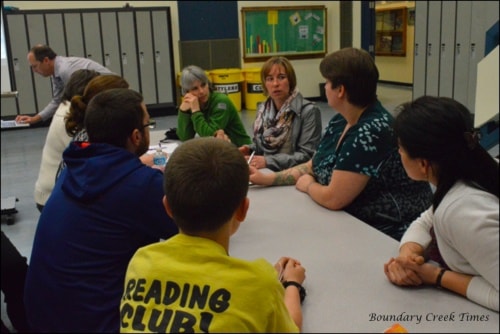School District 51 (Boundary) held two public consultation meetings last week. There was one in the West Boundary on Wednesday, April 8 at BCSS and another in Grand Forks for the East Boundary parents and communities the following night.
On hand at the BCSS meeting were trustees Cathy Riddle, Cindy Strukoff and Rose Zitko along with Superintendent Kevin Argue, Director of Learning Doug Lacey, Brian Foy, principal of the four West Boundary elementary schools, and teacher Jennifer MacDonald.
The three-hour meeting featured a PowerPoint on planning, finance and educational directions.
Argue began with an overview of planning as it is currently done in the district and the resulting documents such as school growth plans and district achievement contracts.
The current district achievement contract has four goals: to embed the inquiry process into teaching and learning throughout SD51; to improve student achievement in reading; to increase access and use of technology to deepen learning and authentically communicate their knowledge; and to improve the positive, social emotional connectedness of our students with their school experience through school initiatives supported by the Health Promoting Schools coordinator.
The room was divided into two discussion groups and Argue asked them to consider the question: How are our goals changing our outcomes for students?
Secretary-Treasurer Jeanette Hanlon then gave a report on the budget now being prepared for the 2015-2016 year.
She noted that since the 2001- 2002 school year enrolment in the district has fallen 39 per cent. From 2,030 in 2001; there are now 1,247 full-time equivalent (FTE) students in the district.
The declining enrolment trend is expected to continue too. There are 1,423 students (by headcount) in the system in September 2010. Last September there are 1,270. That is expected to fall to 1,117 in September 2019.
“Enrolment determines revenue,” Hanlon said. She added that Kindergarten enrolment is a huge number each year. Using birth records and StrongStart numbers, the administration makes educated estimates of what those numbers will be each year.
But even educated guesses can be off. This year they had anticipated 68 or 70 students starting Kindergarten across the district; they have 60.
Hanlon gave an overview of how the district is funded. Funding protection guarantees 98.5 per cent of previous years’ funding to protect against huge fluctuations in student numbers.
Estimated total expenses for the 2015-2016 school year are $16,016,274. Revenue is anticipated to be $15,448,622. This leaves a shortfall of $567,652 that will have to be covered by the $1,200,408 surplus on hand from prior years; leaving, on June 30, 2016, an estimated surplus for future years of $632,756.
Seventy-six per cent of expenditures go to instruction, 15 per cent to operations and maintenance, five per cent to district administration and four per cent to transportation.
The board is challenged in this upcoming budget by a ministry edict that they find $91,880 in administrative savings in the coming year.
The question Hanlon put to the parents and community was: How can our financial decisions best meet student-learning needs?
Learning directions was covered by Lacey, and his question for the evening was: How do we support our teaching staff, parents and local community to take the necessary steps towards meeting the changing needs of our learners?
“We have an education system that has been defined around knowledge gatherers, teachers were sort of the fonts of knowledge giving it to the students,” he said. “Students were regurgitating back the knowledge and if they could do that really well through test writing, essays, etc. they were going to be the powerful youth that are going to graduate from school.
“Many of the businesses and even universities were saying: ‘You know what? These kids aren’t the one who are succeeding out there and those aren’t the skills that we need,’” said Lacey said.
He said schools are now changing the focus of their students from being learners of information to doers. “While still recognizing the importance of the fundamentals of reading, writing and arithmetic, things are moving to problem solving, hands on personalized learning with an increased emphasis on competencies.”
